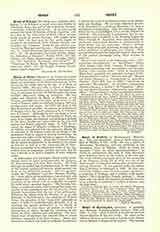

Henry of Huntingdon, historian; b. probably near Ramsey, Huntingdonshire, between 1080 and 1085; d. 1155. Little is known of his life except from chance allusions in his own works. He refers to the Abbot of Ramsey as his lord, to Lincoln as his diocese and to Albinus of Angers as his teacher. The opening section of his “Epistola de contemptu mundi” suggests that he was educated in the household of the Bishop of Lincoln, Robert Bloet (1093-1123). In 1109 or 1110 he was made archdeacon of Huntingdon, so that he was then already a priest. His interest in history was due to a visit to the Abbey of Bee, which he made while accompanying Archbishop Theobald to Rome in 1139, for at Bec he met the Norman historian, Robert de Torigny, who brought to his notice the “Historia Britonum” of Geoffrey of Monmouth. Shortly after he was himself requested by Alexander, Bishop of Lincoln, to undertake the composition of a history, using the writings of Venerable Bede as a groundwork. This he did, carrying the work down to the death of Stephen in 1154. The early part of his work is taken from the customary sources, but from 1127 he is original and writes as an eye-witness. His details are, however, occasionally invented, and his chronology is not reliable. To the later copies of his history he added two books entitled “De miraculis” and “De summitatibus”, the former relating the miracles of several Anglo-Saxon saints, the latter containing his epilogue and three letters on historical subjects. One of these is the “Epistola de contemptu Mundi”, printed in Migne (P.L., CXCV), Wharton (Anglia Sacra, II), and elsewhere as a separate work. Two books of epigrams are found in a Lambeth MS., and according to Leland there were six other books of these, as well as eight books “De Amore”, and treatises “De Herbis”, “De Aromatibus”, “De Gemmis”, and “De Lege Domini”, but these are no longer extant. Probably he died in 1155, as a new archdeacon of Huntingdon is found in that year. His tomb is in Lincoln Cathedral. “Henrici Archidiaconi Huntendunensis Historia Anglorum”, edited by Thomas Arnold (R. S., London, 1879), is the latest and most critical edition, with a valuable introduction. The history, first printed by Savile in “Scriptores post Bedam” (London, 1596), is reprinted in Migne, P.L., CXCV. The “Epistola de contemptu Mundi” is printed in Wharton’s “Anglia Sacra”, II, as well as in the Rolls Series and Migne. One book of the epigrams will be found in Wright’s “Anglo-Latin Satirical Poets and Epigrammatists of the Twelfth Century”, II, R.S. (London, 1872).
EDWIN BURTON

